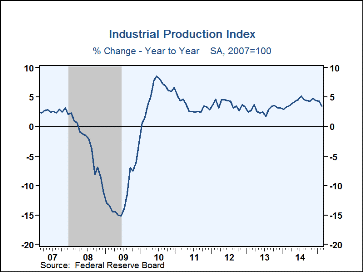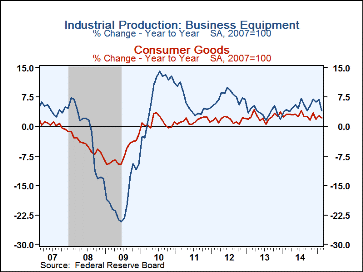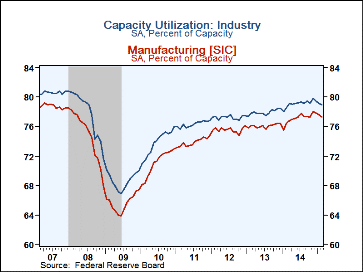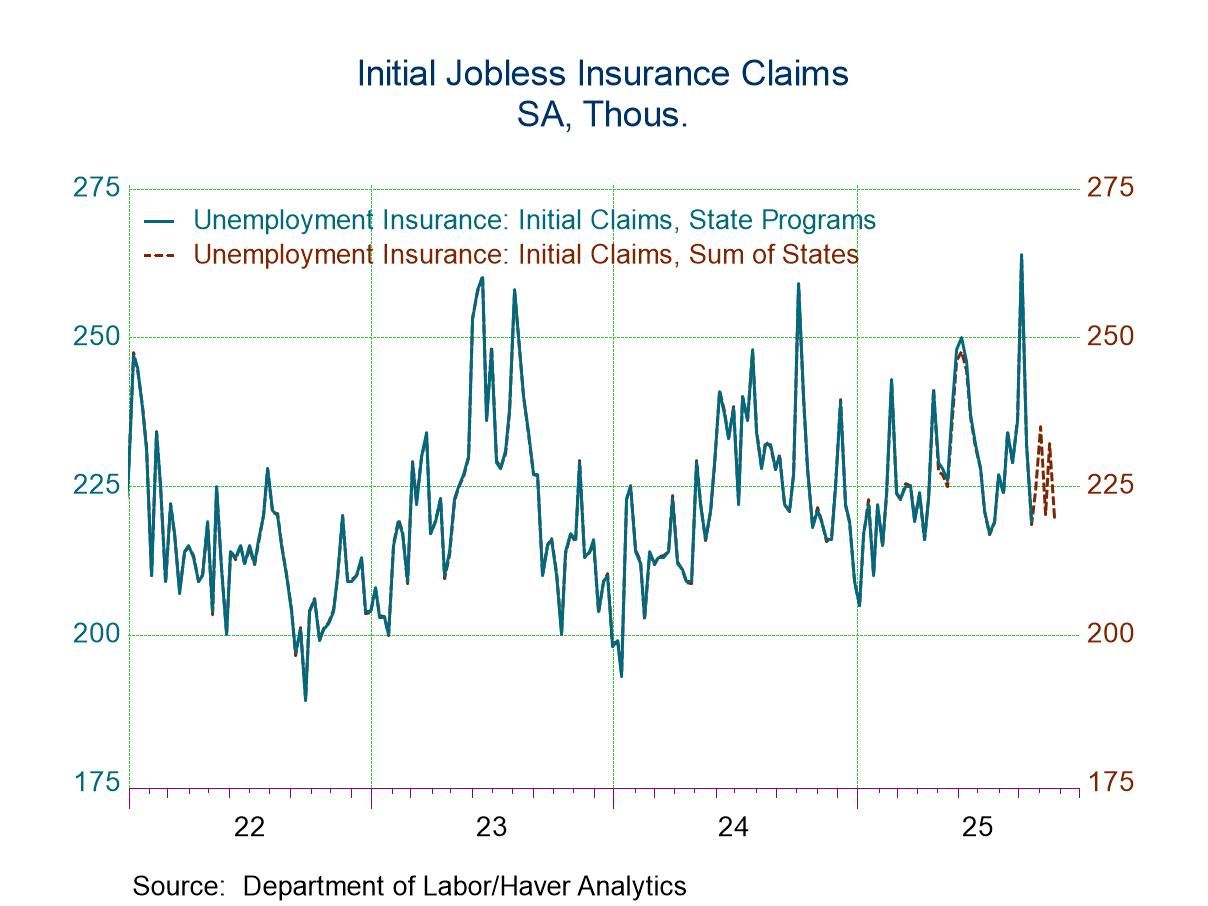 Global| Mar 16 2015
Global| Mar 16 2015U.S. Industrial Production Stabilizes; Factory Output Declines for Three Straight Months
by:Tom Moeller
|in:Economy in Brief
Summary
Industrial production ticked 0.1% higher during February following declines in three of the four previous months. January production fell 0.3%, earlier reported as a 0.2% rise. The latest gain was helped by cold winter temperatures [...]
Industrial production ticked 0.1% higher during February following declines in three of the four previous months. January production fell 0.3%, earlier reported as a 0.2% rise. The latest gain was helped by cold winter temperatures prompting a 7.3% rise (1.2%) in utility output. Manufacturing sector production declined 0.2% (+3.4% y/y). That followed a 0.3% January shortfall, revised from +0.1%, and a 0.1% December slip. A 0.2% rise in total output was expected in the Action Economics Forecast Survey.
Consumer goods production increased 1.0% last month (2.2% y/y). Nondurable consumer goods output was boosted 1.8% (1.8% y/y) by a 7.5% surge (0.4% y/y) in consumer energy products. Chemical products output was unchanged (+5.7% y/y) but clothing production fell 2.3% (+3.6% y/y). Durable consumer goods production declined 1.5% (+3.8% y/y) as motor vehicle & parts production was off 3.0% (+2.9% y/y). Machinery production fell 0.4% (+4.5% y/y) and furniture output slipped 0.1% (+9.0% y/y). Business equipment production fell 0.3% (+4.0% y/y) as industrial equipment output fell 0.6% (+3.1% y/y) and information & processing production slipped 0.2% (+5.1% y/y). Construction supplies output fell 0.3% (+4.1% y/y) and mining production declined 2.6% (+5.3% y/y).
Within the special aggregate series, high technology industries production fell 0.2% (+4.5% y/y), off for the third straight month. Computers & office equipment output dropped 3.7% (-1.4% y/y), also down for three consecutive periods. Communications equipment production was off 0.7% (+5.0% y/y). Factory sector production excluding the high-tech sector fell 0.2% (+3.4% y/y), the same as during the prior two months. Manufacturing production excluding both high-tech and autos remained unchanged (0.3% y/y) following two months of slight decline.
The capacity utilization rate slipped to 78.9% and remained below the recovery high of 79.8% reached in November. In the factory sector, the capacity utilization rate fell to 77.3%, its lowest since October. Total industry capacity rose an improved 3.1% y/y while factory sector capacity increased 2.1% y/y.
Industrial production and capacity data are included in Haver's USECON database, with additional detail in the IP database. The expectations figure is in the AS1REPNA database.
| Industrial Production (SA, % Change) | Feb | Jan | Dec | Feb Y/Y | 2014 | 2013 | 2012 |
|---|---|---|---|---|---|---|---|
| Total Output | 0.1 | -0.3 | -0.2 | 3.4 | 4.2 | 2.9 | 3.8 |
| Manufacturing | -0.2 | -0.3 | -0.1 | 3.4 | 3.5 | 2.7 | 4.1 |
| Consumer Goods | 1.0 | -0.1 | -0.7 | 2.2 | 2.8 | 2.4 | 1.7 |
| Business Equipment | -0.3 | 0.4 | -1.3 | 4.0 | 5.2 | 3.6 | 7.5 |
| Construction Supplies | -0.3 | -1.0 | 1.0 | 4.1 | 4.2 | 4.2 | 4.6 |
| Materials | -0.3 | -0.4 | 0.3 | 4.7 | 5.1 | 3.2 | 4.5 |
| Utilities | 7.3 | 0.9 | -5.0 | 1.2 | 1.3 | 2.1 | -2.1 |
| Capacity Utilization (%) | 78.9 | 79.1 | 79.4 | 78.6 | 79.1 | 78.0 | 77.3 |
| Manufacturing | 77.3 | 77.6 | 77.9 | 76.4 | 77.2 | 76.1 | 75.5 |
Tom Moeller
AuthorMore in Author Profile »Prior to joining Haver Analytics in 2000, Mr. Moeller worked as the Economist at Chancellor Capital Management from 1985 to 1999. There, he developed comprehensive economic forecasts and interpreted economic data for equity and fixed income portfolio managers. Also at Chancellor, Mr. Moeller worked as an equity analyst and was responsible for researching and rating companies in the economically sensitive automobile and housing industries for investment in Chancellor’s equity portfolio. Prior to joining Chancellor, Mr. Moeller was an Economist at Citibank from 1979 to 1984. He also analyzed pricing behavior in the metals industry for the Council on Wage and Price Stability in Washington, D.C. In 1999, Mr. Moeller received the award for most accurate forecast from the Forecasters' Club of New York. From 1990 to 1992 he was President of the New York Association for Business Economists. Mr. Moeller earned an M.B.A. in Finance from Fordham University, where he graduated in 1987. He holds a Bachelor of Arts in Economics from George Washington University.










